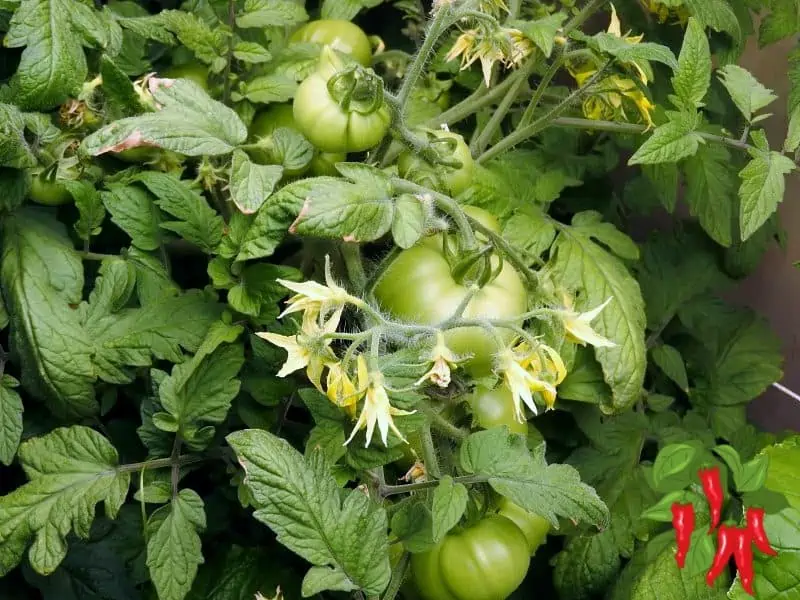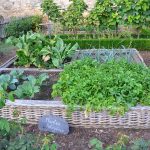This post may contain affiliate links. If you buy something from one of our links we may earn a commission. Thanks
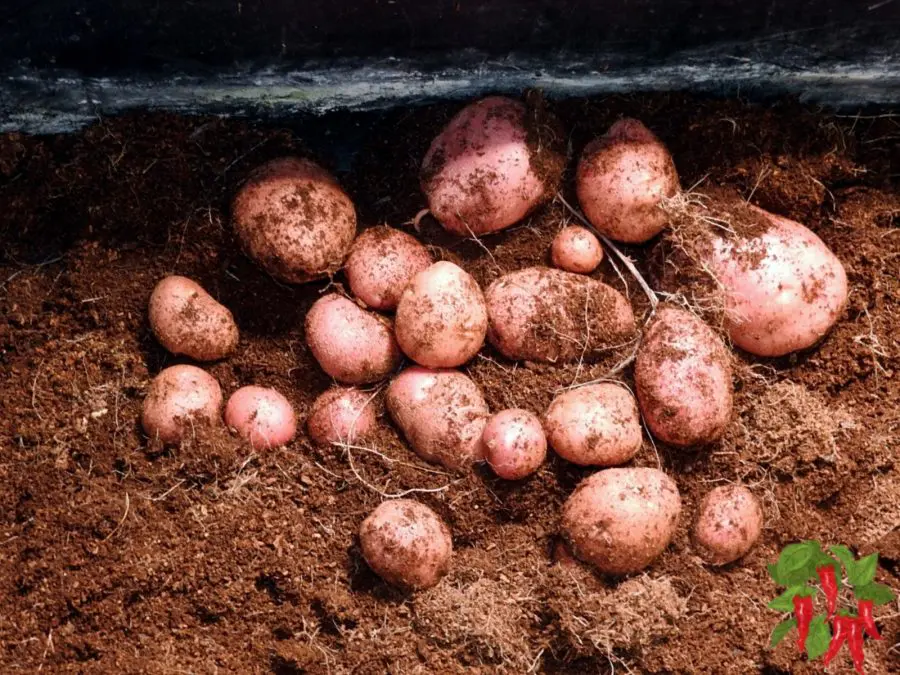
Learn how to grow potatoes indoors without soil and discover growing tasty spuds at home using just a bucket and coco coir – no garden needed!
The Joy of Growing Your Own Food
Hey there, fellow green thumbs! Have you ever wanted to grow your own potatoes right at home, without even needing a backyard garden?
Well, you’re in luck because today we’re going to show you how to grow delicious potatoes in a simple 5-gallon bucket indoors!
Growing your own food is such a rewarding experience, don’t you think? There’s nothing quite like biting into a potato that you nurtured from a little sprout to a full-fledged plant.
And the best part? It’s super easy to do indoors with just a bucket and a few supplies.
Key Takeaways
Now, let me give you the key takeaways upfront so you know what you’re in for:
- We’ll be using coco coir as our growing medium – it’s like potting soil but way better for indoor growing.
- You’ll start by placing a sprouted potato at the bottom of the bucket.
- As your potato plant grows taller, you’ll keep adding more coco coir around the stem to encourage more potato growth.
- Good drainage is a must, so we’ll drill some holes in the bottom of the bucket.
- Potatoes love lots of light, so you’ll want to supplement with a grow light if needed.
- And finally, a cool-ish room temperature is ideal for happy potato plants.
Getting Down to the Root of It
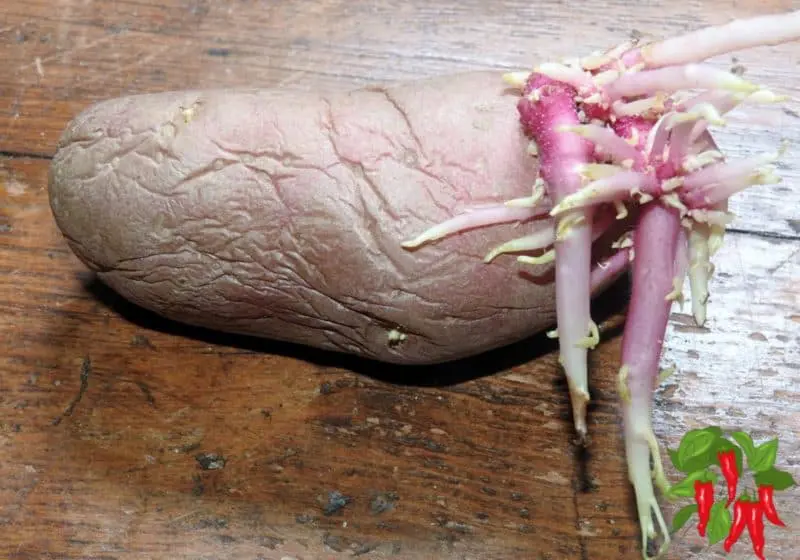
Sounds pretty straightforward, right? Let’s dive into the details!
Potatoes need a nice long growing season, good soil that drains well, and consistent moisture.
Room temperature is perfect for them, and they actually prefer growing in slightly cooler conditions. They like acidic soil to prevent pesky potato scab disease.
While growing potatoes indoors does take some patience since you can’t just pluck them right away, it’s such an enjoyable process to witness those little spuds forming!
Why Coco Coir?
For my indoor potato buckets, I use coco coir as my growing medium instead of regular potting soil.
Garden soil can get too compacted and may bring in unwanted critters or diseases so don’t use it.
Coco coir is made from coconut husks and is awesome for indoor growing.
I like using those classic 5-gallon plastic buckets because they give my potato plants enough depth to spread their roots and tubers.
Plus, they make great little container gardens for bigger veggies like potatoes, tomatoes or peppers.
Smaller containers just won’t cut it for maximum potato yields.
I use a double bucket. The top bucket has the potatoes in it and it has holes drilled in the bottom. I sit in another bucket to catch any runoff.
I never have to drain it but you can use a single bucket set on a saucer.
Setting Up Your Potato Bucket
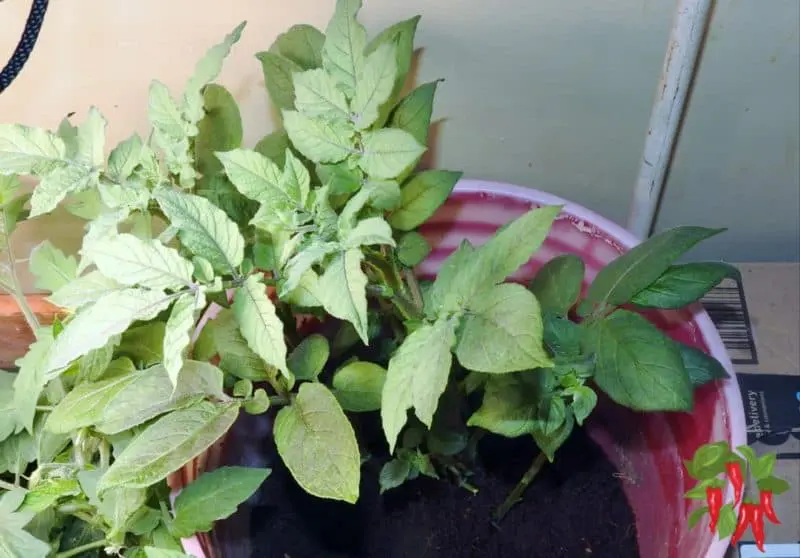
Okay, so here’s how I set up my potato bucket garden…
I start by adding a couple inches of moistened coco coir to the bottom of the bucket.
Then I take my sprouted potato (more on how to prep those in a minute) and plop it right on top of that coir layer and lightly cover it.
As the plant grows taller over the next couple of weeks, I gradually add more coco coir around the stem, leaving just the top leaves uncovered.
This “hilling” technique mimics how farmers grow potatoes by mounding soil around the stems. It encourages the plant to produce more tubers along the buried stem. Sneaky, right?
Oh, as I mentioned I drill a few drainage holes in the bottom of the bucket and actually put it inside another bucket to catch any excess water that drains out.
Make sure your bucket can drain. You don’t want your potato roots sitting in soggy soil.
Prepping Your Potato “Seeds”
Before we get planting, let’s talk about preparing those potato “seeds.” Yep, you can totally grow potatoes from…other potatoes!
They’re part of the nightshade family like tomatoes, so the leaves are toxic – don’t go munching on those.
Potatoes actually grow from these little tuber sections that sprout eyes or buds. When you give them the right conditions, those eyes will start growing into new potato plants.
You can use grocery store potatoes that have already started sprouting eyes and growing little nubs.
Or you can purchase special “seed potatoes” which are certified disease-free. I’ve done both and they both work just fine – the seed potatoes just let you know the exact variety.
Some people cut up bigger potatoes into chunks with one or two eyes each before planting.
Personally, I prefer popping in the whole small potato with its eyes intact. I figure cutting inevitably leads to a wound that could let in diseases or fungi.
No matter which route you take for your seed potatoes, once they have sturdy little sprouts coming off them, they’re ready to plant!
Planting and Hilling
When it comes time to actually getting those babies in the bucket, I put just one sprouted tuber in the bottom of my 5-gallon bucket on that first coco coir layer.
Even if it has multiple sprouts poking out, one potato per bucket is plenty.
As the stems grow up from that potato, I keep removing the lower leaves and burying more of the bare stem with fresh coco coir.
Those leafless stem sections will grow roots and tubers along them – score! I just leave the top leaves uncovered so the plant can continue photosynthesizing.
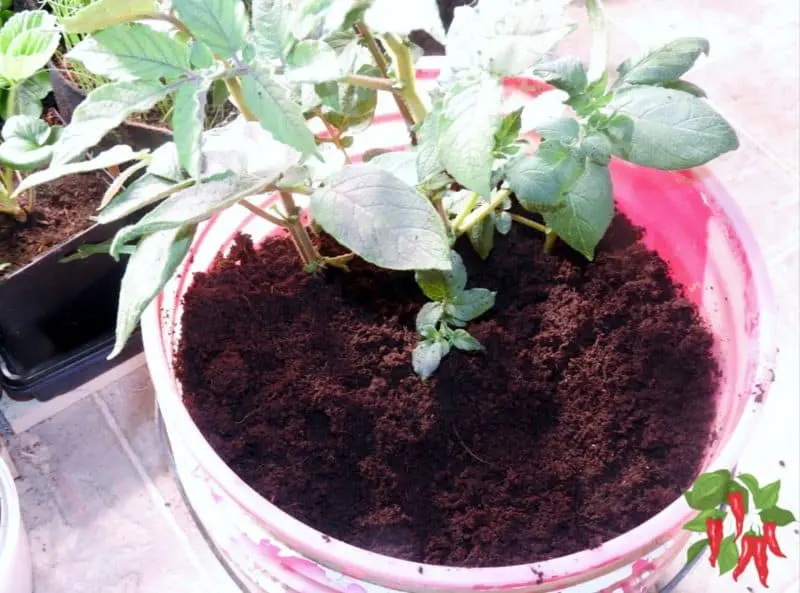
Why Coco Coir Rocks
Since potatoes crave lots of sunlight for optimal growth, I supplement my bucket garden with an LED grow light.
The corner of my house where I keep my buckets doesn’t get much natural light at all.
My garden is under a north-facing window so it won’t get any direct sunlight. I am using a Spider Farmer SF2000 LED .
Oh, and let me reiterate why I love using coco coir so much for this!
I actually grew some beautiful red potatoes in coco coir last year, and they turned out better than any I’d grown in regular potting mix before.
The skins were pristine, no scabs or hollow middles – they were perfection.
Potatoes just thrive in coco coir. It’s renewable and environmentally-friendly compared to non-renewable peat moss.
Coco coir is made from coconut husks and the material is plentiful. Peat moss, on the other hand, is strip-mined from bogs that took thousands of years to form. Not cool.
Coco coir is also pH neutral instead of being super acidic like peat. And it doesn’t need any extra wetting agents or compression – it’s perfectly aerated and drains well right out of the bag.
The Home Stretch
Okay, getting back to my potato bucket garden, as the plants keep growing, I keep hilling that coco coir up around the stems until they get close to the bucket’s rim.
Then I just let them do their thing, keeping the soil moist but not soggy.
You can actually get a peek at the progress by digging around gently with your hands if you’re an impatient potato farmer like me!
Just be careful not to damage the plants if you go rooting around.
Harvesting the Spuds
After a few months of growth, the foliage will start dying back, signaling that your potato harvest is ready! For me, that was around late fall/early winter this time.
At that point, you can finally dump out the bucket and sift through that coco coir to find all your potato treasures! It’s like a little potato mining expedition.
For my first indoor bucket attempt, I pulled out over 3 pounds of potatoes which wasn’t too shabby.
They were a bit smaller than what I get outdoors, likely because I let them dry out a couple times. Potato parenting is hard!
I also used basic grocery store potatoes instead of anything fancy, so I’m expecting better yields next time around when I try specific potato varieties meant for growing indoors or containers.
But either way, there’s something so rewarding about harvesting a fresh batch of homegrown potatoes with your own two hands!
Even if they’re small ones, they’re mighty tasty.
Does this potato bucket growing method sound like something you’d try? I’m looking forward to refining my process and hopefully getting bigger, better potato hauls in the future. It’s such an enjoyable indoor gardening project.
Let me know if you have any other burning potato questions! I’m happy to share more details about my coco coir love affair, funny potato pruning techniques, or whatever else is on your mind. The world of indoor spud farming awaits!
FAQs About Growing Potatoes Indoors Without Soil
Growing potatoes indoors in a 5-gallon bucket with coco coir might raise various questions, especially for beginners.
Our FAQ section aims to cover common questions from the preparation stage to the harvesting phase.
We provide insights and ensure a fruitful potato growing journey, even within the constraints of indoor gardening.
Q. How do I prepare my seed potatoes for planting in a 5-gallon bucket?
A. Begin by selecting healthy sprouting potatoes or certified seed potatoes. If using larger potatoes, you can cut them into chunks ensuring each piece has at least one eye.
However, using small whole potatoes with multiple eyes is preferable as it reduces the risk of disease. Once they have sturdy sprouts, they’re ready to plant.
Q. How often should I water my potato plants growing in a 5-gallon bucket indoors?
A. Keep the coco coir growing medium moist but not waterlogged. The frequency of watering may vary based on the room temperature and humidity. It’s crucial to ensure good drainage to prevent water stagnation which can lead to rot.
Q. When and how should I harvest potatoes grown in a 5-gallon bucket indoors?
A. Harvesting can be done once the foliage starts to die back, or after 10-20 weeks of planting. Gently empty the bucket and sift through the coco coir to collect your potatoes. It’s a fun process, almost like a little potato mining expedition.
How To Grow Potatoes Indoors Without Soil: Conclusion
Growing potatoes indoors without soil is an incredibly rewarding experience that’s easier than you might think. Here are a few key points to remember:
Grow Potatoes Without Soil Key Takeaways:
- Use a 5-gallon bucket filled with coco coir instead of soil.
- Plant a sprouted potato tuber at the bottom and gradually “hill” the plant by adding more coco coir around the stem as it grows.
- Provide ample light, consistent moisture, and cool temperatures for best results.
Potatoes Thrive in Coco Coir
- Coco coir provides excellent drainage and aeration for indoor potato growth
- It’s a renewable, environmentally-friendly alternative to peat moss
- The near-neutral pH is ideal for potato plants
Bucket Gardening is Convenient
- 5-gallon buckets offer the perfect depth for potato tuber development
- The “hilling” technique maximizes yields in a small space
- Drill drainage holes and use a catch bucket to prevent overwatering
Enjoy the Process
- Be patient as potato plants can take several months to reach maturity indoors
- Periodically inspect for new potato growth by gently digging around
- Revel in the satisfaction of a homegrown potato harvest!
Read more: Indoor Apartment Gardening: 15 Point Comprehensive Guide
Visit my Amazon Influencer Page for videos and gardening products Grow Your Own Garden



